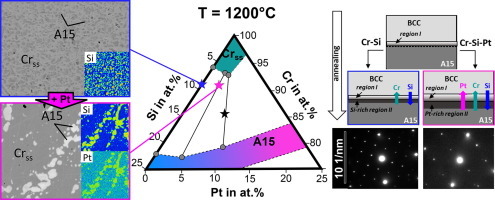A.S. Ulrich, A.J. Knowles, V. Cantatore, A. Bhowmik, M.T. Wharmby, C. Geers, I. Panas, M.C. Galetz
Materials & Design 218 (2022), 110655, DOI: 10.1016/j.matdes.2022.110655

The effect of alloying Cr-rich Cr-Si alloys with Pt was investigated by a combination of complementary experimental methods and atomic scale modelling. The investigated Cr-Si and Cr-Si-Pt (Cr ≥86 at.%) alloys developed a two-phase microstructure consisting of Cr solid solution (Crss) matrix and strengthened by A15 precipitates during annealing at 1200°C. It was found that additions of 2 at.% Pt increase the coarsening rate by almost five times considering annealing times up to 522 h. Pt was found to change the precipitate matrix orientation relationship, despite its low influence on the Crss matrix/A15 precipitate misfit. Through this experimental and modelling approach new insight has been gained into mechanisms of enhanced coarsening by Pt addition. The increased coarsening is principally attributed to a change in interface composition and structure resulting in different thermodynamic stabilities: Pt-containing A15 phase was found to have a broader compositional range if both elements, Pt and Si, are present compared to only Si. Additionally, the Crss phase was found to have a higher solubility of Pt and Si over just Si. Both factors additionally facilitated Ostwald ripening.